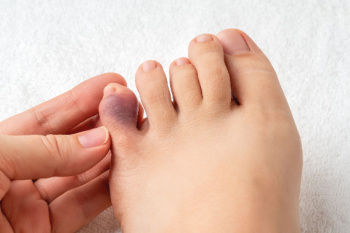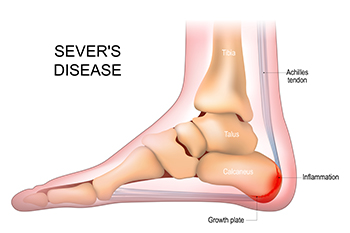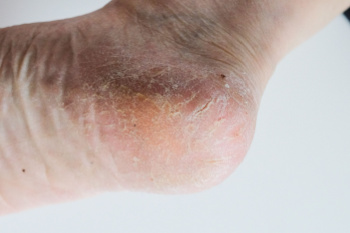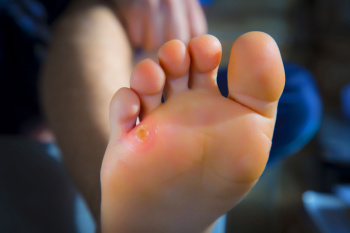
A broken pinky toe often results from accidental impact or trauma, such as stubbing the toe or dropping a heavy object on it. The symptoms of a fractured pinky toe include significant pain, swelling, bruising, and difficulty in moving the toe. In severe cases, the toe may appear deformed or out of alignment. To find relief, it is essential to rest the injured foot and avoid putting weight on it. Relief may be found by elevating the foot as this can assist in minimizing inflammation. Mild pain relievers may alleviate discomfort. In cases of severe injury or if the toe appears dislocated, seeking medical attention from a podiatrist is critical for a proper diagnosis and treatment. If you have fractured your toe, it is suggested that you promptly contact this foot doctor for the appropriate treatment.
Broken toes may cause a lot of pain and should be treated as soon as possible. If you have any concerns about your feet, contact Bruce Smit, DPM from Frankfort Foot & Ankle Clinic. Our doctor will treat your foot and ankle needs.
What Is a Broken Toe?
A broken toe occurs when one or more of the toe bones of the foot are broken after an injury. Injuries such as stubbing your toe or dropping a heavy object on it may cause a toe fracture.
Symptoms of a Broken Toe
Although the injured toe should be monitored daily, it is especially important to have a podiatrist look at your toe if you have severe symptoms. Some of these symptoms include worsening or new pain that is not relieved with medication, sores, redness, or open wounds near the toe.
If you have any questions, please feel free to contact our office located in Frankfort, IL . We offer the newest diagnostic and treatment technologies for all your foot care needs.

Sever's disease, also known as calcaneal apophysitis, is a common condition affecting children and adolescents, particularly those aged 8 to 14. It occurs when the growth plate in the heel becomes inflamed due to repetitive stress or overuse. This inflammation results from the strong pull of the Achilles tendon on the developing heel bone. Symptoms of Sever's disease can include heel pain, tenderness, and swelling, particularly during or after physical activities like running or jumping. Children may also experience discomfort while walking or participating in sports. This condition often resolves with rest, wearing proper footwear, and stretching exercises for the calf muscles and Achilles tendon. If your active child has heel pain, it is suggested that you promptly consult a podiatrist who can provide an accurate diagnosis and offer treatment.
Sever's disease often occurs in children and teens. If your child is experiencing foot or ankle pain, see Bruce Smit, DPM from Frankfort Foot & Ankle Clinic. Our doctor can treat your child’s foot and ankle needs.
Sever’s Disease
Sever’s disease is also known as calcaneal apophysitis, which is a medical condition that causes heel pain I none or both feet. The disease is known to affect children between the ages of 8 and 14.
Sever’s disease occurs when part of the child’s heel known as the growth plate (calcaneal epiphysis) is attached to the Achilles tendon. This area can suffer injury when the muscles and tendons of the growing foot do not keep pace with bone growth. Therefore, the constant pain which one experiences at the back of the heel will make the child unable to put any weight on the heel. The child is then forced to walk on their toes.
Symptoms
Acute pain – Pain associated with Sever’s disease is usually felt in the heel when the child engages in physical activity such as walking, jumping and or running.
Highly active – Children who are very active are among the most susceptible in experiencing Sever’s disease, because of the stress and tension placed on their feet.
If you have any questions, please feel free to contact our office located in Frankfort, IL . We offer the newest diagnostic and treatment technologies for all your foot and ankle injuries.
 Cracked heels, or heel fissures, are splits in the skin on the heels often caused by dry, thickened skin and excessive pressure on the feet. Factors such as prolonged standing, wearing open-back shoes, obesity, and skin conditions like eczema can contribute to their development. Anyone can experience cracked heels, but they are more common in older adults and those with diabetes. Relief may come from moisturizing, exfoliating, and wearing supportive footwear. If you have deep heel cracks that are painful or show signs of infection, it is suggested that you schedule an appointment for treatment with a podiatrist as quickly as possible to prevent complications. This foot doctor will often prescribe medication for complete healing.
Cracked heels, or heel fissures, are splits in the skin on the heels often caused by dry, thickened skin and excessive pressure on the feet. Factors such as prolonged standing, wearing open-back shoes, obesity, and skin conditions like eczema can contribute to their development. Anyone can experience cracked heels, but they are more common in older adults and those with diabetes. Relief may come from moisturizing, exfoliating, and wearing supportive footwear. If you have deep heel cracks that are painful or show signs of infection, it is suggested that you schedule an appointment for treatment with a podiatrist as quickly as possible to prevent complications. This foot doctor will often prescribe medication for complete healing.
Cracked heels are unsightly and can cause further damage to your shoes and feet. If you have any concerns, contact Bruce Smit, DPM from Frankfort Foot & Ankle Clinic. Our doctor can provide the care you need to keep you pain-free and on your feet.
Cracked Heels
Cracked heels appear unappealing and can make it harder for you walk around in sandals. Aside from looking unpleasant, cracked heels can also tear stockings, socks, and wear out your shoes. There are several methods to help restore a cracked heel and prevent further damage.
How Do You Get Them?
Dry skin is the number one culprit in creating cracked heels. Many athletes, walkers, joggers, and even swimmers suffer from cracked heels. Age and skin oil production play a role to getting cracked heels as well.
Promote Healing
Over the counter medicines can help, especially for those that need instant relief or who suffer from chronic dry feet.
Wear Socks – Wearing socks with medicated creams helps lock in moisture.
Moisturizers – Applying both day and night will help alleviate dryness which causes cracking.
Pumice Stones – These exfoliate and remove dead skin, which allows for smoother moisturizer application and better absorption into the skin.
Change in Diet
Eating healthy with a well-balanced diet will give the skin a fresh and radiant look. Your body responds to the kinds of food you ingest. Omega-3 fatty acids and zinc supplements can also revitalize skin tissue.
Most importantly, seek professional help if unsure how to proceed in treating cracked heels. A podiatrist will help you with any questions or information needed.
If you have any questions, please feel free to contact our office located in Frankfort, IL . We offer the newest diagnostic and treatment technologies for all your foot care needs.
 Corns and calluses are thickened areas of skin resulting from mechanical hyperkeratosis, which is a protective response to repeated friction or pressure. Corns, typically found on toes, are small, circular, and often painful. Calluses are larger, less defined, and usually form on weight-bearing areas like the soles of the feet. These conditions arise due to wearing poorly fitting shoes, abnormal gait, or prolonged activities causing excessive pressure on certain foot areas. Prevention includes wearing well-fitted, comfortable shoes and using protective pads or insoles to reduce pressure points. Regularly moisturizing feet can also help to keep the skin supple and less prone to thickening. Relief involves reducing the source of friction and gently filing thickened skin after soaking feet in warm water. If you have severe corns or calluses that are causing excessive pain, it is suggested that you schedule an appointment for an examination with a podiatrist.
Corns and calluses are thickened areas of skin resulting from mechanical hyperkeratosis, which is a protective response to repeated friction or pressure. Corns, typically found on toes, are small, circular, and often painful. Calluses are larger, less defined, and usually form on weight-bearing areas like the soles of the feet. These conditions arise due to wearing poorly fitting shoes, abnormal gait, or prolonged activities causing excessive pressure on certain foot areas. Prevention includes wearing well-fitted, comfortable shoes and using protective pads or insoles to reduce pressure points. Regularly moisturizing feet can also help to keep the skin supple and less prone to thickening. Relief involves reducing the source of friction and gently filing thickened skin after soaking feet in warm water. If you have severe corns or calluses that are causing excessive pain, it is suggested that you schedule an appointment for an examination with a podiatrist.
Corns can make walking very painful and should be treated immediately. If you have questions regarding your feet and ankles, contact Bruce Smit, DPM of Frankfort Foot & Ankle Clinic. Our doctor will treat your foot and ankle needs.
Corns: What Are They? And How Do You Get Rid of Them?
Corns are thickened areas on the skin that can become painful. They are caused by excessive pressure and friction on the skin. Corns press into the deeper layers of the skin and are usually round in shape.
Ways to Prevent Corns
There are many ways to get rid of painful corns such as:
Treating Corns
Although most corns slowly disappear when the friction or pressure stops, this isn’t always the case. Consult with your podiatrist to determine the best treatment option for your case of corns.
If you have any questions please feel free to contact our office located in Frankfort, IL . We offer the newest diagnostic and treatment technologies for all your foot and ankle needs.